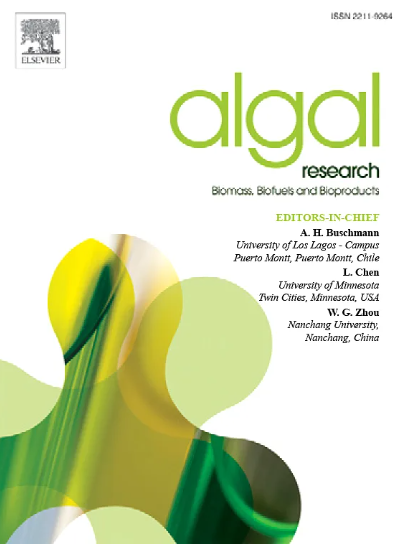感知:新物种表观遗传调节剂预测的R闪亮管道
IF 4.5
2区 生物学
Q1 BIOTECHNOLOGY & APPLIED MICROBIOLOGY
Algal Research-Biomass Biofuels and Bioproducts
Pub Date : 2025-06-10
DOI:10.1016/j.algal.2025.104142
引用次数: 0
摘要
表观遗传过程是调节基因表达、基因组稳定性和整个生命之树的代谢功能的核心;然而,它们在微藻中的作用仍未得到充分探索,特别是随着新物种的不断发现和表征。这可能是由于表观遗传湿实验室方法的繁琐性质和物种依赖属性,这妨碍了快速识别表观遗传修饰和调节剂。然而,从芽殖酵母到人类的表观遗传过程高度保守;在许多情况下,人们可以通过识别表观遗传调节剂或负责赋予表观遗传修饰的蛋白质来推断新物种的行为和功能是如何被表观遗传调节的。为此,我们开发了一个图形软件包,名为PERCEPTIVE(新物种表观遗传调节剂预测管道)。该平台仅使用藻类物种的基因组序列和其他模式生物的预先存在信息来预测藻类的表观遗传调节剂和相关修饰。预测以图形界面呈现给用户,该界面提供基于文献的结果解释,使用户能够快速了解其感兴趣的藻类物种的潜在表观遗传过程并计划后续实验。为了测试PERCEPTIVE,我们预测了几种原料候选藻类物种的表观遗传调节剂。为了验证这些预测,进行了湿实验室研究,包括质谱分析;这些结果强调了PERCEPTIVE预测的高准确性。总的来说,PERCEPTIVE代表了一个强大的硅芯片工具,用于研究和操纵藻类物种,它不需要先验的表观遗传学知识,并且可供广泛的研究人员使用。本文章由计算机程序翻译,如有差异,请以英文原文为准。
PERCEPTIVE: an R shiny pipeline for the prediction of epigenetic modulators in novel species
Epigenetic processes are central to regulating gene expression, genome stability, and metabolic function across the tree of life; yet, their roles remain underexplored in microalgae, especially as new species continue to be identified and characterized. This is likely due to the cumbersome nature and species-dependent attributes of epigenetic wet-lab methodologies, which preclude the rapid identification of epigenetic modifications and modulators. However, there is high conservation of epigenetic processes from budding yeast to humans; in many cases, one may infer how behavior and function are epigenetically regulated in novel species by identifying epigenetic modulators, or the proteins responsible for conferring epigenetic modifications. To this end, we have developed a graphical software package, titled PERCEPTIVE (pipeline for the prediction of epigenetic modulators in novel species). This platform solely uses the genomic sequence of an algal species, and preexisting information from other model organisms, to predict the epigenetic modulators and associated modifications in algae. Predictions are presented to the user in a graphical interface, which provides literature-based interpretation of results, enabling users to quickly understand potential epigenetic processes in their algal species of interest and plan follow-up experiments. To test PERCEPTIVE, we predicted epigenetic modulators in several feedstock candidate algae species. To validate these predictions, wet-lab studies were performed, including mass spectrometry; these results underscore the high accuracy of PERCEPTIVE predictions. Overall, PERCEPTIVE represents a powerful in silico tool for the research and manipulation of algal species, which does not require a priori knowledge of epigenetics and is accessible to a broad set of investigators.
求助全文
通过发布文献求助,成功后即可免费获取论文全文。
去求助
来源期刊

Algal Research-Biomass Biofuels and Bioproducts
BIOTECHNOLOGY & APPLIED MICROBIOLOGY-
CiteScore
9.40
自引率
7.80%
发文量
332
期刊介绍:
Algal Research is an international phycology journal covering all areas of emerging technologies in algae biology, biomass production, cultivation, harvesting, extraction, bioproducts, biorefinery, engineering, and econometrics. Algae is defined to include cyanobacteria, microalgae, and protists and symbionts of interest in biotechnology. The journal publishes original research and reviews for the following scope: algal biology, including but not exclusive to: phylogeny, biodiversity, molecular traits, metabolic regulation, and genetic engineering, algal cultivation, e.g. phototrophic systems, heterotrophic systems, and mixotrophic systems, algal harvesting and extraction systems, biotechnology to convert algal biomass and components into biofuels and bioproducts, e.g., nutraceuticals, pharmaceuticals, animal feed, plastics, etc. algal products and their economic assessment
 求助内容:
求助内容: 应助结果提醒方式:
应助结果提醒方式:


